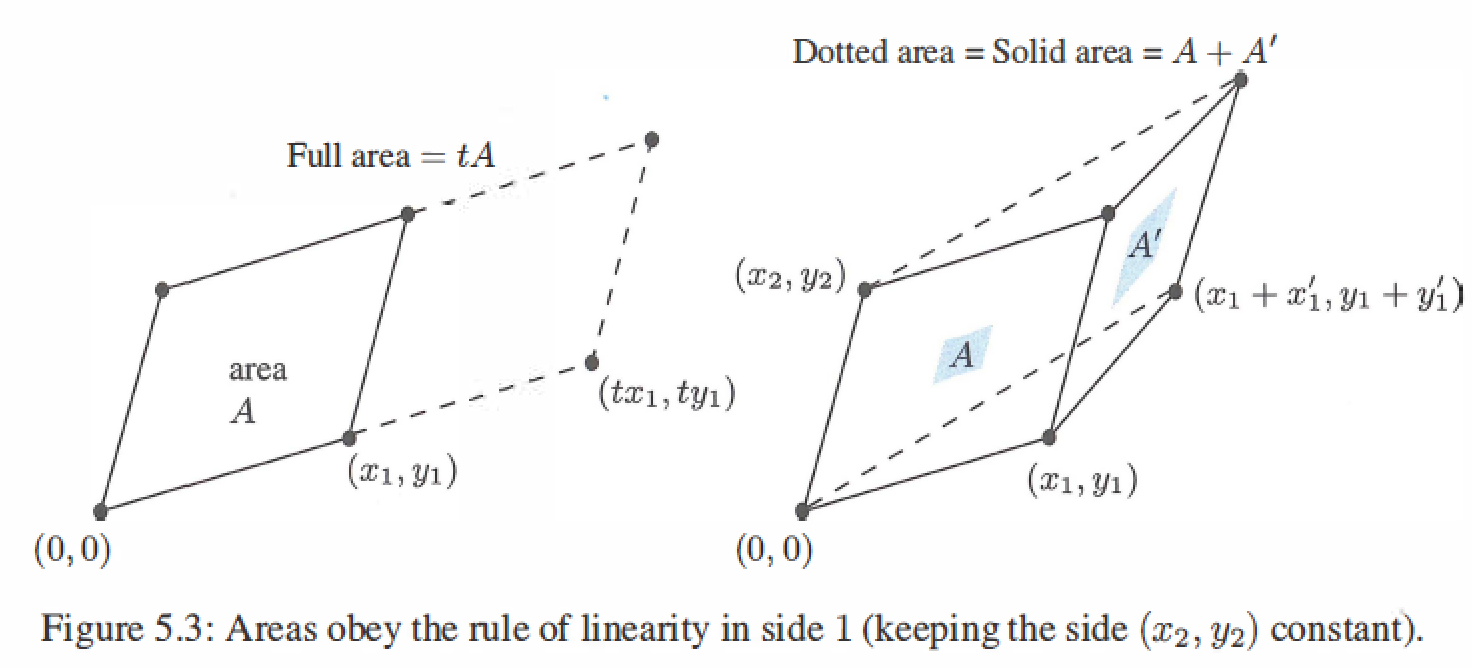5. Determinant
5.1 The Properties of Determinants
-
The determinant of the n by n identity matrix is 1 : \(det I = 1\).
-
The determinant changes sign when two rows are exchanged(sign reversal) : \(det P = \pm 1\) (det P = +1 for an even number of row exchange and det P = -1 for an odd number.)
-
The determinant is linear function of each row separately :
- 3a : multiply row i for any number t det is multiplied by t : \(\left[ \begin{matrix} ta&tb \\ c&d \end{matrix} \right] = t\left| \begin{matrix} a&b \\ c&d \end{matrix} \right|\)
- 3b: add row i of A to row i of A' then determinants add : \(\left[ \begin{matrix} a+a'&b+b' \\ c&d \end{matrix} \right] = \left| \begin{matrix} a&b \\ c&d \end{matrix} \right| + \left| \begin{matrix} a'&b' \\ c&d \end{matrix} \right|\)
From rules 1-3 we will reach rules 4-10.
-
If two rows of A are equal, the det A = 0.
-
Subtracting a multiple of one row from another row leaves det A unchanged. ( eliminaton steps doesn't change determinant : det A = det D, without row exchanges.)
-
A matrix with a row of zeros has det A = 0.
-
If A is triangular then \(det A = a_{11}a_{22}...a_{nn}\)=product of diagnonal entries.
-
If A is singular then det A = 0. If A is invertible then \(det A \neq 0\).
-
The determinant of AB is det A times det B : \(|AB| = |A||B|\) .
-
The transpose \(A^T\) has the same determinant as A: \(det A^T = det A\).
- A zero column will make the det A = 0.
- Two equal columns will make the det A = 0.
- If a column is multiplied by t, so is the determinant.
5.2 Three Formula for Determinant
The Pivot Formula
When elimination leads to \(A=LU\), the pivots \(d_1,d_2,...,d_n\) are on the diagonal of the upper triangular U.
No row exchanges: \(det A = (det L)(det U)=(1)(d_1d_2...d_n)\)
Row exchanges: \((detP)(detA)= (detL)(detU)\) gives \(detA = \pm(d_1d_2...d_n)\) , odd leads to minus(-), even leads to plus(+)
The Big Formula
The big formula has n! terms.
example:
The Cofactors Formula
The determinant is the dot product of any row i of A with its cofactors using other rows:
Each cofactor \(C_{ij}\) (order n-1, without row i and column j) includes its correct sign:
example:
5.3 Inverse\ Cramer's Rule\ Volumn of box
Formula for \(A^{-1}\)
The i, j entry of \(A^{-1}\) is the cofactor \(C_{ji}\) divided by det A:
proof :
Cramer's Rule
If det A is not zero, Ax=b is solved by determinants:
The matrix \(B_j\) has the jth column of A replaced by the vector b.
example:
Volumn of box
The volume equals the absolute value of det A.

Area of Parallelogram and Triangle
Determinants are the best way to find area.
Area of Parallelogram : \(Area = Determinant\)
Area of Triangle: \(Area = Determinant / 2\)

When an edge is stretched by a factor t, the volume is multiplied by t. (Rule 3a)
When edge 1 is added to edge 1', the volume is the sum of the two original volumes.(Rule 3b)

5.4 Cross Product
The cross product of \(u=(u_1,u_2,u_3)\) and \(v=(v_1,v_2,v_3)\) is a vector.
The cross product is a vector with length \(||u|| \ \ ||v|| \ \ |sin\theta|\). Its direction is perpendicular to u and v.It points "up" or "down" by the right hand rule.








